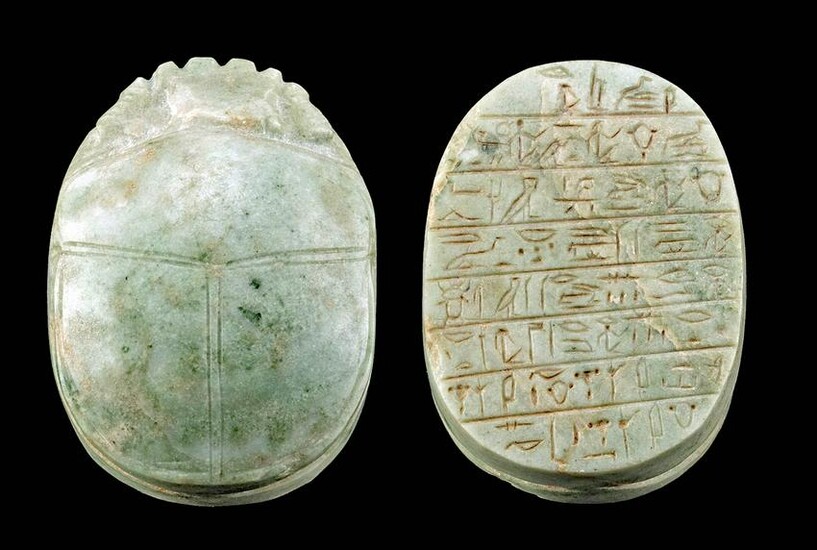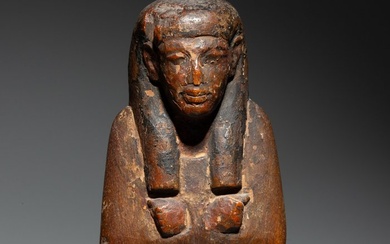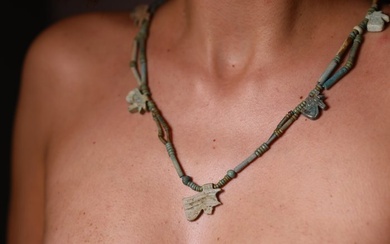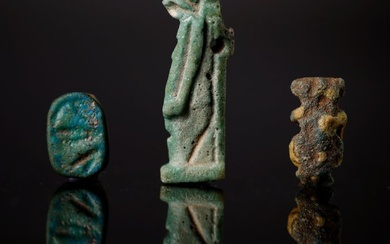Important Egyptian New Kingdom Jasper Heart Scarab
Ancient Egypt, New Kingdom Period, 18th to 20th Dynasty, ca. 1550 to 1077 BCE. A superb and attractive example of a heart scarab carved from mottled sage-green jasper with forest green and faint beige inclusions. The topside of the ovoid amulet is carefully detailed with characteristic insectile features including slender legs tucked beneath the body, a three-part wing carapace with parallel striations delineating each section, a petite head with a pair of laterally bulging eyes, and a frilled clypeus of a semicircular form. The bottom displays 8 condensed lines of inscribed hieroglyphs, read right to left, from Chapter 30B of the Egyptian Book of the Dead which commands the deceased's heart to not betray him during the weighing of the heart ceremony. This piece is of great importance because of the blank space left in the first line. This space was to be filled with the name of the deceased 'customer,' indicating this heart scarab was carved for commercial purposes rather than for a specific individual. Size: 1.9" L x 1.375" W x 0.85" H (4.8 cm x 3.5 cm x 2.2 cm)
The ancient Egyptians believed that a person's heart contained proof of whether they had behaved well or badly in life. No one could claim a life free of sin, but if they were lucky enough to own a heart scarab, they could cheat their way into the afterlife. The journey through the afterlife was full of obstacles and challenges. The final hurdle was to be judged at the court of Osiris. Here a person's heart was removed and weighed by the god Anubis. Wicked people had heavy hearts and were sent to 'Hell' by way of having their soul consumed for all eternity by a nightmarish amalgam creature called Ammit. A light heart meant an honest life and entry to the afterlife. Heart scarabs were placed inside the mummy close to the heart. A person's greatest fear was that their heart would speak out against them during the final judgement. So, a magical spell - Chapter 30B of the Book of the Dead (or the Book of Going Forth by Day) - inscribed beneath the scarab silenced the heart and guaranteed entry into the afterlife.
Cf. The Metropolitan Museum of Art, accession number 10.130.1644; The British Museum, museum number EA7884
This piece has been searched against the Art Loss Register database and has been cleared. The Art Loss Register maintains the world's largest database of stolen art, collectibles, and antiques.
Provenance: private Toronto, Ontario, Canada collection, by descent, acquired in Egypt in 1894 to 1896
All items legal to buy/sell under U.S. Statute covering cultural patrimony Code 2600, CHAPTER 14, and are guaranteed to be as described or your money back.
A Certificate of Authenticity will accompany all winning bids.
PLEASE NOTE: Due to recent increases of shipments being seized by Australian & German customs (even for items with pre-UNESCO provenance), we will no longer ship most antiquities and ancient Chinese art to Australia & Germany. For categories of items that are acceptable to ship to Australia or Germany, please contact us directly or work with your local customs brokerage firm.
Display stands not described as included/custom in the item description are for photography purposes only and will not be included with the item upon shipping.
#167111
Condition Report: Small chips to lower periphery, with softening to some finer details along topside, otherwise intact and excellent. Fantastic surface smoothness throughout, with great preservation to inscribed hieroglyphs along bottom. Hieroglyphs are still clear and legible with only a gap along the top line for the customer's name to be inserted.
View it on
Estimate
Time, Location
Auction House
Ancient Egypt, New Kingdom Period, 18th to 20th Dynasty, ca. 1550 to 1077 BCE. A superb and attractive example of a heart scarab carved from mottled sage-green jasper with forest green and faint beige inclusions. The topside of the ovoid amulet is carefully detailed with characteristic insectile features including slender legs tucked beneath the body, a three-part wing carapace with parallel striations delineating each section, a petite head with a pair of laterally bulging eyes, and a frilled clypeus of a semicircular form. The bottom displays 8 condensed lines of inscribed hieroglyphs, read right to left, from Chapter 30B of the Egyptian Book of the Dead which commands the deceased's heart to not betray him during the weighing of the heart ceremony. This piece is of great importance because of the blank space left in the first line. This space was to be filled with the name of the deceased 'customer,' indicating this heart scarab was carved for commercial purposes rather than for a specific individual. Size: 1.9" L x 1.375" W x 0.85" H (4.8 cm x 3.5 cm x 2.2 cm)
The ancient Egyptians believed that a person's heart contained proof of whether they had behaved well or badly in life. No one could claim a life free of sin, but if they were lucky enough to own a heart scarab, they could cheat their way into the afterlife. The journey through the afterlife was full of obstacles and challenges. The final hurdle was to be judged at the court of Osiris. Here a person's heart was removed and weighed by the god Anubis. Wicked people had heavy hearts and were sent to 'Hell' by way of having their soul consumed for all eternity by a nightmarish amalgam creature called Ammit. A light heart meant an honest life and entry to the afterlife. Heart scarabs were placed inside the mummy close to the heart. A person's greatest fear was that their heart would speak out against them during the final judgement. So, a magical spell - Chapter 30B of the Book of the Dead (or the Book of Going Forth by Day) - inscribed beneath the scarab silenced the heart and guaranteed entry into the afterlife.
Cf. The Metropolitan Museum of Art, accession number 10.130.1644; The British Museum, museum number EA7884
This piece has been searched against the Art Loss Register database and has been cleared. The Art Loss Register maintains the world's largest database of stolen art, collectibles, and antiques.
Provenance: private Toronto, Ontario, Canada collection, by descent, acquired in Egypt in 1894 to 1896
All items legal to buy/sell under U.S. Statute covering cultural patrimony Code 2600, CHAPTER 14, and are guaranteed to be as described or your money back.
A Certificate of Authenticity will accompany all winning bids.
PLEASE NOTE: Due to recent increases of shipments being seized by Australian & German customs (even for items with pre-UNESCO provenance), we will no longer ship most antiquities and ancient Chinese art to Australia & Germany. For categories of items that are acceptable to ship to Australia or Germany, please contact us directly or work with your local customs brokerage firm.
Display stands not described as included/custom in the item description are for photography purposes only and will not be included with the item upon shipping.
#167111
Condition Report: Small chips to lower periphery, with softening to some finer details along topside, otherwise intact and excellent. Fantastic surface smoothness throughout, with great preservation to inscribed hieroglyphs along bottom. Hieroglyphs are still clear and legible with only a gap along the top line for the customer's name to be inserted.







